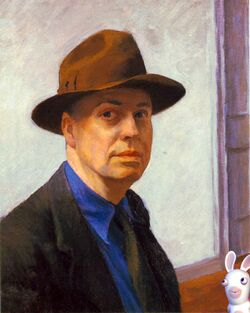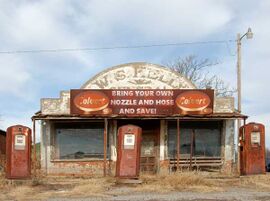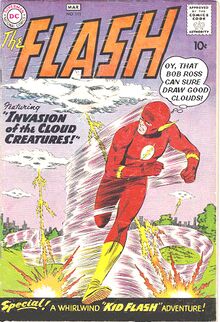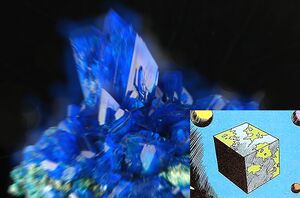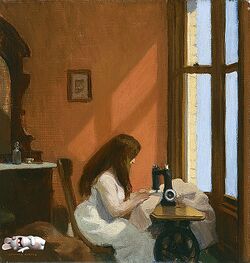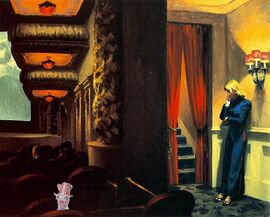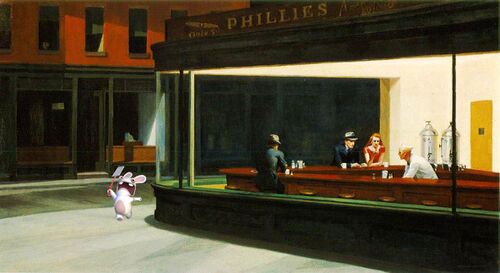Edward Hopper
Edward Hopper (July 22, 1882 – May 15, 1967) was a 20th Century painter lumped into the Realist painting school by people who think they are smarter than you. He painted a variety of everyday subjects: seascapes, landscapes, normal people doing normal things, carnival prizes, mustaches on billboards. If his work were shown today in the typical sidewalk art show, he'd be so penniless he'd been using stolen ketchup and mustard packets for paint. People nowadays adore "Magic Light" reproduction paintings and 8-bit Pokémon images. Any physical paintings they acquire have usually been stolen from motel rooms.
Though he is largely famous for his oil paintings, Hopper worked in other media as well. He painted watercolors and produced etchings as well as doing a bit of paper money counterfeiting.[1] He has also been suspected of forging the works of prolific art forger Elmyr de Hory in retaliation for creating forgeries of Hopper's paintings.
Early life
Hopper was born to an Upper Nyack, New York upper middle class family whose only purpose was to be upper middle class. Art materials were freely available to him from an early age and he was able to have one of the earliest boxes of 32 different Crayolas[2] whereas most children had boxes of 12.
Hopper was a precocious artist. After being mesmerized by a color picture of Michelangelo's Sistine Chapel painting, he reproduced it in exacting detail using only crayons on the ceiling of his parent’s dining room. Similar to Michelangelo’s predicament, he ran out of blue crayons.[3] The work does not survive today due to a fussy housekeeper cleaning it off days after it was drawn.
Rather than punish him, his family installed canvases on the ceilings of the entire house. Sales of his paintings at local flea markets were brisk, bringing much-needed cash for necessities like Old Crow and Four Roses[4]. After a time, an interesting offer was made. Being of good patrician stock, the family held out for the highest price possible before selling Edward into slavery. After a stint at the Keene gallery, specializing in painting tear ducts, he ran away and eventually returned to his family.
At age 14, he was asked by his father to paint a gas station owned by the family. Hopper fell to the task readily, producing a neorealistic large oil painting on Masonite board. It was only when he presented it to his family one month later that he found out that "paint the gas station" meant "paint the gas station". He would never paint in that style again.
Art education
While intending to follow studies and a career in fine art, his parents encouraged him to pursue a career in commercial illustration in order to get him to move out of the family house. Hopper was amenable to this since this was done at gunpoint.[5]
While sitting dejectedly in the gutter, he found a comic book – The Flash no. 111. On the back was an ad for The Infamous Illustrators School. He took out a piece of paper, mailed in his sample drawing, and was accepted.[6] He paid his last $45,000 in pocket money to them for training and graduated with honors.[7]
Hopper made a deal with his family to go into commercial illustration if they supported his efforts to study Fine Arts. Thinking he meant going on trips to the museum, they readily agreed. He was accepted to the famous New York School of Design and Deli Arts (NYSDDA).
He studied first under C.M. Coolidge, producing the respected but derivative Two Cows Playing Pinochle. Hopper then attempted to specialize in still life but had become so meticulous in planning by this time that the fruit used for models would rot before he finished a painting. He then turned to cubism until he found it wasn’t a sculpture medium and he had to keep pounding on his head to get the images right.
There was a brief setback when exchange student Lucian Freud stole Hopper's special color mixes for portrait painting. When Hopper found out, he beat Freud and broke several of the latter's fingers, accounting for Freud's rugged portrait style. A resultant concussion explains Freud's later penchant for strange-looking nude women.
One of Hopper's teachers and influences was Robert Henri, a co-founder of the Ashcan School. While Hopper took some stylistic influences from the group, he went his own way. Art critics point out the Hopper did own an ashcan at the time so that makes him a member.
At NYSDDA he met Frida Kahlo, briefly having a relationship with her. It ended when he insisted she grow sideburns to go with the mustache. When she later married muralist Diego Rivera, she had Hopper embedded in a block of carbonite and had Rivera paint a mural on the back. This was just part of a plan to capture Jedi Master David Siqueiros.
Early career
Edward Hopper did the mandatory struggling artist thing, although without contracting tuberculosis or cutting off any ears. His first job was at Coney Island painting turtles. Once again, his extensive planning did him no good as competitor Andrew Wyeth outpainted him in turtles 12 to 1. Still, as a result, turtles painted by Hopper now reach auction prices exceeding those of Wyeth's.
Hopper then went on to do face painting on the Atlantic City boardwalk. While it is generally agreed that Hopper's clown costume was excellent, new competitor Pablo Picasso was preferred by customers and art critics for his palette and bold designs. Due to prescient parents realizing the future value of both of their works, many had their children decapitated and their heads freeze-dried so that future generations could worry about their parents doing the same thing.[8]
He then hired on to do the commercial illustration work that he had earlier despised. Hopper quickly rose to the third assistant in the elongated oval drawing department at the Batton Barton Durstine and Ozzy Osbourne (BBD&OO) advertising agency. He is thought to have been responsible for billboard advertising for Hebrew National, Chicago Hot Dog, Nathan's and Oscar Mayer.
Still, he hated his job, particularly when he liked hamburgers much better, and sought a transfer to the hot sandwich animation department. He did win several awards for his commercial work which included lettering the date and issue numbers on magazine covers. His magic X-ray glasses ad for the Johnson-Smith Novelty Co. remains a classic in the field.[9]
He made his first major sale from an exhibition outside a Staten Island garbage dump for a shiny new Mercury dime, and it was off to the races. Hopper was disappointed to find that the minimum bet there was $2 and resolved to do better. The artist did this by using his paints to color the dime gold and passed it off as a $10 gold piece.
By 1924 he had reached the exalted level of starving artist beneath the notice of major galleries.
Marriage and success
The artist ran into an earlier acquaintance, artist Josephine Nivison, in an art supply store during a fight to the death over the last no. 6 filbert brush. Romance followed and they were married in 1924. Suddenly, they realized because both were artists, there was a real danger of death by slow starvation. Edward Hopper then went into a painting frenzy, determined for both to be able to eat food and live with a roof over their heads. Hopper would paint on the walls in subway stations and inside subway cars, giving cleaning people fits but paving the way for artistic taggers creating complex pieces. While waiting for the light to change at street corners, he could produce at least one complete painting on a corner building.
His wife was his biggest promoter at the time, following him around with hacksaw and chisel and recovering the pictures he had painted. These she would sell on weekends at local flea markets and through bodegas in Manhattan as Santeria religious icons.
While waiting in line for the Brooklyn Museum to open, Hopper cranked out painting after painting on its interior walls. Critics entering later to attend a Bob Ross retrospective took particular notice of the paintings. Convinced of their quality because they were already in a museum, they ran back home and wrote glowing reviews of the works they had seen. The artist had finally arrived. One work that was particularly well-received was painted on the back of security guard who had fallen asleep sitting on a bench. The Rockefeller Family bought it and the security guard for $500. He still sleeps on a bench inside a gallery located inside their estate floating in the clouds above Far Rockaway.
This led to a new interest in earlier paintings which he could now sell. Buyers appreciated the fact that those were on canvas and not on pieces of a two-foot-thick concrete wall. The Hoppers appreciated the fact that they no longer had to live by eating library paste and drinking from puddles of water from the roof.
Style and important works
Hopper has been thrown into so many schools of painting it is unbelievable that he escaped without major injury. Aside from the Ashcan group, he has been dumped into the Precisionist school which was begun by the thoroughbred race horse of the same name. He is lumped in with super-realists like Andrew Wyeth and industrial photographers by art critics who constantly leave their glasses on the dresser when they leave the house. His only link with Dadaism and the Surrealists is that he would take his spoiled paintings and forge Marcel Duchamp and Salvador Dali signatures on them. Hopper cannot be considered a member of the Brutalists since he had a low opinion of its founders, the 3 Stooges. In the end, his own kung fu was too strong.[10] Realistically, Hopper can only be really considered a Realist, in reality.
The bright and airy Girl at Sewing Machine (1921) records a time when Hopper was getting a Halloween costume made. To gain time to finish the work, Hopper would pull out stitches when the subject had left the room to do other things. Upon discovering the ruse, the young woman also became the subject of Girl Chasing Me With Scissors (1921). That was followed by the third work in the series, Waiting in Emergency Room With Balls in a Glass Jar (1921).
Hopper's meticulous planning and research is typified in The House by the Railroad (1925). It was a frustrating experience – 137 trains passed before the artist decided to just capture the tracks and house only. The distraction of his change in plan caused him to fail to include the owner of the house leaning out a second-floor window, mooning the painter.
New York Movie (1939) demonstrated a typical theme for Hopper. It focused on a lone figure in a large space within a contemporary everyday setting. Yet again, a further mysterious backstory is also suggested, in this case the ironic destruction of the theater by King Kong as theatergoers watch a King Kong movie.[11]
Effete soi-disant know-it-alls consider his body of work a commentary on the coldness and bleakness of 20th Century life. In actuality, effete know-it-alls are the cause of that coldness and bleakness in life. His compositions of lone figures reinforce that delusion in a group that has no real friends. The celebrated work Nighthawks (1942) is used by this confederacy of dunces as a key example justifying their viewpoint. Rather, it is a depiction of a quiet safe harbor in the trying times of World War II, as smugly pointed out by the Practical Pig wing of self-styled know-it-alls.[12]
When asked late in life why his works often showed contrasts in light and dark tones, he admitted that he got a really great deal on white and black paints from Winsor Newton[13] that was too good to pass up. He then spent most of his career trying to use all of it up. His restrained palette of colors for each painting came from his usage of his original Crayola box for preliminary studies. "I had to wing it on the blues since I never replaced them," the artist said. It is said that his choices there came from the European Blau Reiter paintball team that always used its team color during annual competitions against American Realists.
Death and legacy
Edward Hopper died of exhaustion in his studio on May 15, 1967, hours after finishing his 99 Bottles of Beer series. That was created in an effort to use up all his remaining white and black paint.
Hopper always regretted that he became a painter in oils rather than somebody really famous like respected comics artists Carl Barks and Jack Kirby, lauded landscapist Tim Cooper or famed portraitist "Roy" (Williams) of the Mickey Mouse Club. His great fear was that sometime in the future his paintings would be sold as reproductions on paper with bumps imitating brushmarks[14] and would be vandalized by the lowest dregs of society.[15]
Mid-career, Hopper caused anxiety among wealthy art buyers who moaned they could have bought his paintings dirt cheap if they had jumped on the bandwagon early on. His death overjoyed them as the prices for his paintings rose tremendously without having to pay for an expensive KGB assassination.
Early on, Hopper began to suspect buyers of his paintings were more interested in investment value over art. This bothered him so much that he began to incorporate secret messages into his newer paintings, that could only be seen under blacklight or even only during a solar eclipse. Screw you, Elmyr de Hory (1948) is one of those works. Hopper decided to take this even further. He would break into galleries, museums and collectors' mansions, paint something unknown on his paintings there, then cover the new image with special paints that would fade after about fifty years. Word of these "modifications" was only found after his death after study of his voluminous notes. Art experts and collectors have since denied seeing any change in Hopper paintings.
Many of his works now hang in major museums around the world that had classical works stolen and needed something to fill blank spaces on the walls. Hopper's paintings are now also used for blocking off areas in museums under construction.[16]
| Featured version: 27 January 2018 | |
| This article has been featured on the main page. — You can vote for or nominate your favourite articles at Uncyclopedia:VFH. | |
Footnotes
- ↑ This was for the FBI, in World War II. It was used to pay for a Chanel gown for J. Edgar (REDACTED), an inexpensive one, really. Ignore the Nazi middlemen and the German submarine used to ship it. Nothing to see here, move along.
- ↑ With the built-in crayon sharpener; aren’t you jealous?
- ↑ It was later found that a classmate, Wassily "Woz" Kandinsky had stolen them.
- ↑ Feel the burn.
- ↑ Experts disagree whether this was a .30-06 or a .40-.40.
- ↑ as was everyone else who ever applied.
- ↑ as was everyone else who paid for tuition.
- ↑ See Ed Gein, How to Get Ahead (Putnam, 1953).
- ↑ It beat out Norman Rockwell's well-regarded and equally long-lived bold lettering of "B.O." in deodorant ads in the 1920 Advertising Age competition.
- ↑ See Charlie Chan Meets the Expressionist School, RKO (1938).
- ↑ Yes, yes, King Kong was carrying an iron at the time, smartypants.
- ↑ Oink.
- ↑ the illegitimate son of Fig and Little Debbie
- ↑ Done.
- ↑ Done.
- ↑ This article is dedicated to art and art history major graduates and dilettantes who actually got all the references to artists. Now go back to flipping burgers before the boss finds out you know how to read.
